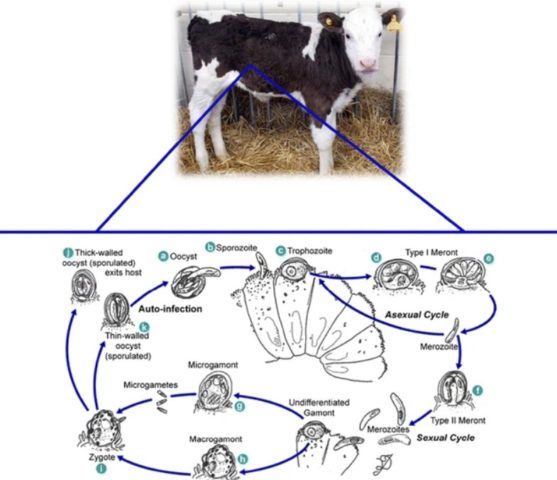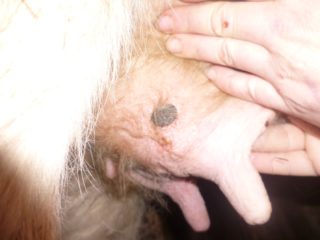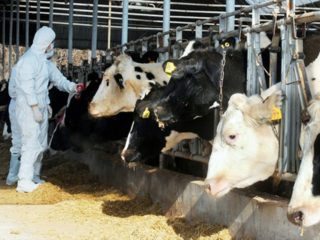Content
Cryptosporidiosis in calves is a type of coccidiosis specific to cattle. But, unlike eimeriosis in cattle, which is innocent against its background, it can cause economic damage. When infected with cryptosporidium, a calf has only two options: die or recover. More than half “choose” the first.
What kind of disease is cryptosporidiosis?
The pathogen is a parasitic single-celled organism that can cause pulmonary and gastrointestinal diseases. Calves are susceptible to infection by the species Cryptosporidium parvum. Cryptosporidiosis mainly affects newborns. The profuse watery diarrhea caused by the parasite provokes dehydration and death.
Cryptosporidium provokes the development of enteritis in calves. Unlike Eimeria, these single-celled organisms do not leave their “host” at the end of their life cycle. Some of them remain in the epithelial cells of the ileum and continue to function.

The graph shows that 57% of all intestinal diseases of young calves are due to cryptosporidiosis, “pure” or mixed with other infections
Pathogenesis
Calves under 6 weeks of age are most susceptible to cryptosporidiosis. This does not mean that an older animal cannot become infected with parasites. Moreover, cryptosporidium that “reaches” the victim will most likely remain there forever. But when infected after 6 weeks of age, the disease is asymptomatic.
The oocyst “spores” that enter the calf’s intestines pass to the second stage of development – Cryptosporidium parvum sporozoites. The latter adhere to cells in the upper part of the small intestine. Once attached, the sporozoites form a protective “bubble” that separates the parasite from both the “external environment” and the internal contents of the host cell. The membrane created by cryptosporidium allows it to receive nutrients from the host and protects it from the host’s immune response. This is why the pathogen is so difficult to fight.
After creating a shelter, sporozoites transform into trophozoites, which are capable of reproducing sexually and asexually. During reproduction, 2 types of oocysts are formed. The thin-walled ones return to the intestinal epithelial cells, again infecting the host. Thick-walled ones are released into the external environment with feces.

Cryptosporidium life cycle diagram
Diagnosis of cryptosporidiosis in calves
The disease in cattle is caused by 4 types of cryptosporidium:
- parvum;
- bovis;
- ryanae;
- andersoni.
But only the first causes disease in newborn calves and asymptomatic release of oocysts in older animals. Researchers believe that the distribution of different types of cryptosporidium depends on the age of the cattle. Cryptosporidium andersoni most often affects the abomasum of adult cattle. The remaining three species “tend” to infect young animals.
The diagnosis is made comprehensively:
- symptoms;
- epizootic situation in the area;
- laboratory tests of feces.
Excrement is examined in several ways for reliability. In both methods, the sample is stained. In this case, the oocysts either do not stain at all or weakly “take” the paint. Darling or Fulleborn methods are also used. These methods use a saturated solution of sucrose or salt.
Symptoms
The incubation period for cryptosporidiosis in newborn calves is 3-4 days. Symptoms of C. Parvum infection:
- refusal to eat;
- profuse watery diarrhea;
- dehydration;
- coma.
The calf falls into a coma if time was lost. Due to dehydration. Diarrhea usually appears 3-4 days after infection with parasites. Duration 1-2 weeks. Release of oocysts into the external environment occurs between 4 and 12 days after infection with cryptosporidium. These spores become dangerous to healthy animals immediately after entering the external environment.
When infected with C. andersoni, to which adult animals are susceptible, decreased weight and milk production are added to the clinical signs.

The main symptom of cryptosporidiosis in a calf is profuse diarrhea.
Biochemical blood parameters
Infection with cryptosporidiosis can also be determined by a biochemical blood test. True, this relates more to diagnostics for the sake of determining the epizootic situation. Treatment should begin on the first day.
With cryptosporidiosis in calves, the content of total protein in the blood decreases by 9.3%, albumin - by 26.2%. This indicates impaired protein absorption from the intestine and impaired liver function. The total amount of globulins in a calf disease increases by 8.9%:
- α-globulin is almost at the same level;
- β-globulin – higher by 21.2%;
- γ-globulin – by 8.8%.
Other indicators also change. Based on the general results of a biochemical blood test, it can be said that when a calf is infected with cryptosporidiosis, not only intestinal function is disrupted. Degenerative processes develop in the liver. This does not allow the body to neutralize toxins that are formed as a result of the vital activity of parasites.
Features of the spread of the disease
Infection of newborn calves with cryptosporidium oocysts occurs through the oral or intrauterine route. Since an adult cow can also become infected with cryptosporidiosis or remain a carrier of the parasite after recovery, calves are born already sick. In this case, signs of the disease appear already 1-2 days after birth.
Calves born healthy become infected through contact with the feces of sick animals or by consuming water or feed contaminated with droppings. Oocysts can be everywhere in the environment if litter and barnyards are not kept clean.

Cryptosporidiosis can be transmitted from calves to humans
How dangerous is the disease?
Cryptosporidiosis brings not only economic losses. Research into this disease has shown that not only animals, but also people become infected with parasites. Moreover, it is the species C. parvum that is the main causative agent of cryptosporidiosis in young animals.
Since there is practically no time for diagnosis, owners often make a mistake and begin to treat calves for simple diarrhea, which can be caused by the queen being in heat. Accordingly, the newborn either survives despite the “treatment” or dies. Mortality from dehydration among young calves reaches 60%.
How to treat cryptosporidiosis in calves
There are no effective medications against cryptosporidiosis in calves. The following are often prescribed for treatment:
- sulfadimezin;
- chemical coccide;
- aprolium;
- norsulfazole;
- paromomycin.
All these drugs do not stop the course of the disease, but they reduce the number of oocysts secreted by the sick calf. Chemical coccide is a coccidiostat. These drugs do not cure, but allow the animal to develop immunity.
Polymyxin is also recommended in combination with furazolidone for 6 days. The antibiotic dose is 30-40 thousand units. The total volume of the composition is 6-10 mg/kg. Abroad, all these drugs for calves are not licensed.
Halofuginone lactate
The only licensed product is halofuginone lactate. However, no one knows for sure the mechanism of action of the drug. There is a version that it affects the sporozoite and merozoite stages of the body.

Halokur is one of the most popular brands of halofuginone lactate.
Rules of application
Halofuginone lactate is used for the prevention and treatment of cryptosporidiosis in young animals. For prophylactic purposes, the drug is used during the first 1-2 days after the birth of a calf. Treatment should be started within the first 24 hours after the onset of diarrhea. The medicine is produced in liquid form. The dosage is calculated individually for each calf: 0.1 mg of halofuginone per 1 kg of live weight. The concentration of the active substance in drugs of different brands may differ. The manufacturer must indicate the specific dosage of its product in the instructions.
Halofuginone is given at the same time every day. During treatment, the calf is provided with a sufficient amount of milk or colostrum. The drug is mixed into the feed for 7 days.
Forbidden
Use halofuginone lactate on weakened animals. Give the drug to calves that have diarrhea for more than 24 hours. Feed the medicine before feeding.
Halofuginone lactate is not able to completely prevent infection or cure the calf, but it does shorten the duration of diarrhea and reduce the number of oocysts released. Other means are even less effective.
Adjuvant therapy
Although in the case of cryptosporidiosis it is more logical to call it the main one. Sick calves are provided with dietary nutrition. They make droppers with drugs that restore the water-salt balance. Enveloping decoctions are soldered.
Use of probiotics
Probiotics are also considered adjuvant therapy. They are unable to cure the calf. Here you can only restore the intestinal microflora that died as a result of the use of antibiotics. But there is another opinion: bacteria reproduce well on their own. In any case, probiotics will not make things worse.
The drugs are given orally, with warm water instead of one of the feedings.

Adjuncts can be added to calves during feeding or in drinking troughs
Prevention measures
There is no vaccine for cryptosporidiosis. They are trying to create it, but so far to no avail. Therefore, you should not count on vaccinations.
Oocysts are very difficult to remove from the environment, so preventative measures can only be to reduce contamination and stimulate the calf's natural immunity.
Optimal housing and feeding conditions are created for pregnant cows. The litter is cleaned frequently and thoroughly. Calving areas and calf sheds are disinfected. There are various methods of disinfection:
- ferry;
- disinfectant solution based on hydrogen peroxide, formaldehyde (10%) or ammonia (5%);
- hot water followed by drying the surface;
- burning by fire.
Oocysts are sensitive to extreme temperatures: from - 20 ° C to + 60 ° C.
Sick calves are immediately isolated. Maintenance personnel are treated and systematically examined for the presence of cryptosporidium in feces.
It is also impossible to replenish the herd with animals from disadvantaged farms.
Conclusion
Cryptosporidiosis in calves is a difficult to treat disease that is transmitted to humans. Since there is no vaccine or treatment for this disease, the risk of infection in calves must be reduced as much as possible. And here prevention comes to the fore.








